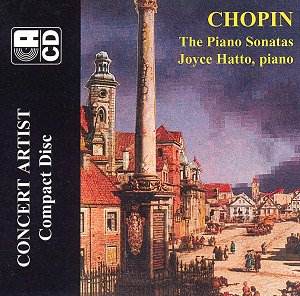This is the logical way to present Chopin’s three
sonatas, one would have thought. After all, they fit nicely onto
one disc, coming in at around an hour and a quarter’s combined
playing time. But the problem is No. 1. Always regarded less as
the poor cousin to Nos. 2 and 3, more the destitute outcast, it
has usually been superseded by, well, anything else when it comes
to filling up the remaining playing time. True, Chopin was only
17 years old and still at the Warsaw Conservatory when he wrote
it, but surely it deserves a better fate then the oblivion it
has been consigned to?
I have only reviewed one performance of the first
Sonata before. That was Joanna Trzeciak on Pavane
ADW7291 (nicely coupled with the four Rondos, which do not
upstage the piece in the manner that Opp. 35 and 58 do). That
was an acceptable performance. Unfortunately, Hatto does not quite
fill the gap. Her laudatory biography at Concert Artist’s website
(http://www.concertartistrecordings.com/joycehatto.htm)
prepares the listener for a treat. Or, seen another way, gives
her a lot to live up to.
There is certainly the impression that Op. 4
has been treated with the disdain it is accustomed to and prepared
mainly (or, indeed, only) in the interests of a complete edition.
There is an uncomfortable literalism in the first movement coupled
with a certain over-careful approach. The First Sonata needs,
if anything, more, not less, championing than the others. If Hatto’s
finale is more exciting than in the hands of Trzeciak, it is too
little too late to save this performance.
Of course, the competition opens out for the
mighty twosome. Nice of Hatto to include the first movement repeat
in No. 2, but she can hardly approach the majesty of, say, Pollini
on DG, to name but one example. The first movement is certainly
agitato (fast and furious might be more apposite), but things
get worse in the Scherzo, where the repeated notes, which should
zing with energy, sound like a Polish stutter. If the famous Funeral
March is imbued with a slow sense of inevitability, the contrasting
theme which should enter like a shaft of light here falls flat
on its face. The finale is ultra-fast, with little pedal, but
the eerie mystery is missing.
The Third Sonata fares better. The first movement
is grand, and Romantically shaded. Right hand legato is well projected.
Hatto uses a pearly tone in the second movement Scherzo (here
there is really good playing), but things go awry again in the
final two movements. Despite a fair smattering of tender moments,
the Largo needs more concentration to sustain its length. The
finale possesses impressive finger-work which, at times, glistens.
But interpretatively misjudged accents can disrupt the flow, a
big mistake in a movement where cumulative energy is all
I had hoped for more.
Colin Clarke
